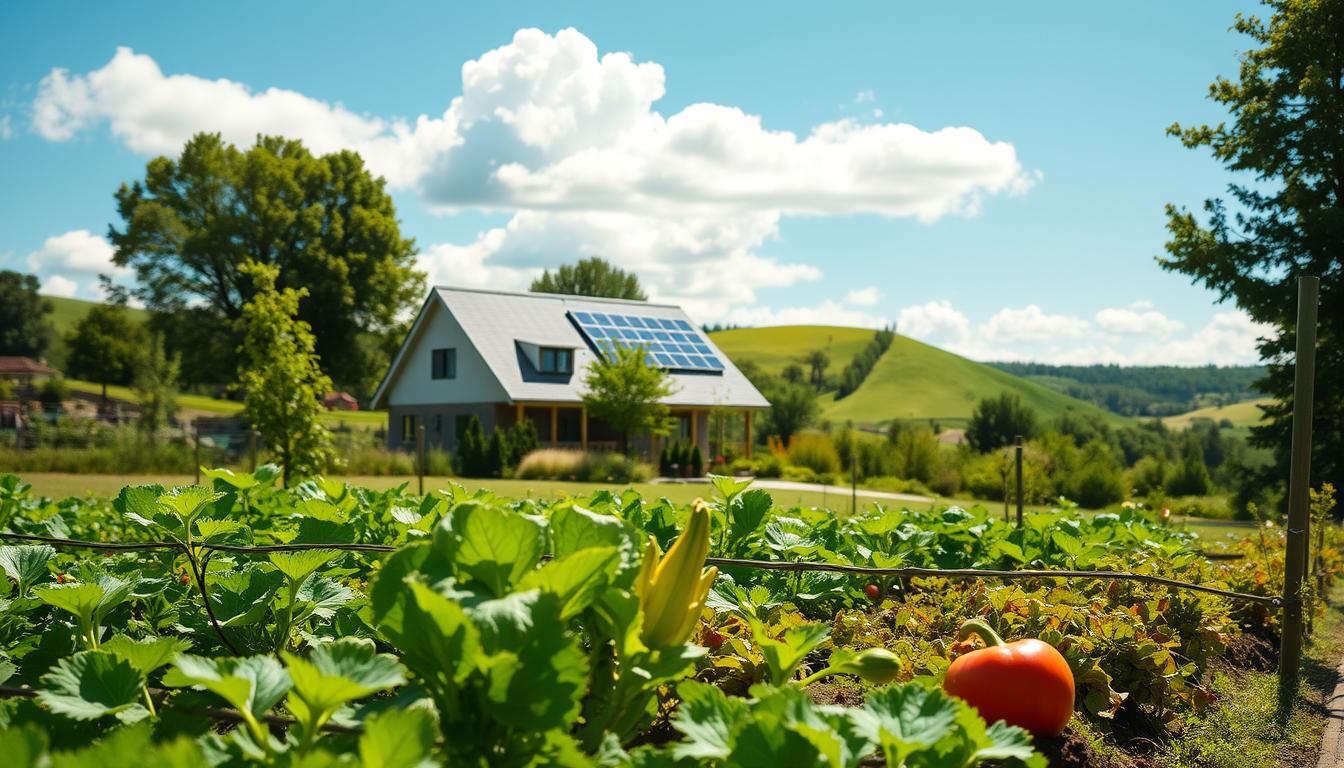Did you know that more than 20 million people are displaced each year due to climate change impacts1? This staggering statistic underscores the urgent need for sustainable living practices. As we step into 2025, adopting eco-friendly habits is no longer a choice but a necessity. These habits not only improve personal wellness but also contribute significantly to the health of our planet.
Today, health and sustainability are deeply intertwined. Simple changes, such as reducing energy consumption or using sustainable products, can make a significant impact. For instance, energy-saving light bulbs last up to 12 times longer than traditional bulbs, achieving 80-90% energy efficiency1. These small steps can collectively lead to a substantial reduction in carbon emissions, ensuring a better future for generations to come.
This year is pivotal for embracing new eco-friendly practices. By making conscious choices, such as upgrading to double-glazed windows or using public transport, we can significantly reduce our carbon footprint. The time to act is now, as the benefits of these habits will resonate for years to come.
Key Takeaways
- Adopting eco-friendly habits is essential for addressing climate change impacts.
- Simple changes, like using energy-efficient appliances, can significantly reduce carbon emissions.
- Sustainable living practices improve personal health and contribute to planetary well-being.
- Small, consistent efforts can lead to substantial environmental benefits over time.
- 2025 is a critical year for implementing new eco-friendly practices.
Introduction to Eco-Friendly Living
As the world grapples with rising temperatures and environmental degradation, the need for sustainable practices has never been more urgent. Eco-friendly living, or green living, is a lifestyle choice aimed at reducing our impact on the planet. It involves making conscious decisions in our daily lives to minimize waste, conserve resources, and promote sustainability.
What is Green Living?
Green living is a way of life that emphasizes harmony with the environment. It’s about making small, consistent changes that collectively have a big impact. For instance, reducing plastic use or conserving water can significantly lower your carbon footprint. These habits not only benefit the planet but also improve personal health and well-being.
Why 2025 Is the Year to Go Green
2025 marks a critical juncture in our fight against climate change. With global plastic production reaching 400 million metric tons annually2, and the U.S. generating 292.4 million tons of trash in 20182, the need for change is clear. By adopting eco-friendly habits, such as recycling more and using sustainable products, we can make a difference. For example, recycling and reusing textiles could reduce greenhouse gas emissions by 44 million tons annually by 20303.
| Challenge | Solution | Benefit |
|---|---|---|
| High Carbon Emissions | Adopt Plant-Based Diets | Reduces greenhouse gases by 74.9%2 |
| Plastic Pollution | Use Reusable Products | Cuts down on single-use plastics |
| Water Scarcity | Conserve Water | Reduces global water risk by 20%3 |
These simple changes can lead to significant environmental benefits. By making eco-friendly choices, we not only help the planet but also improve our own health and well-being. Now is the time to act and make a positive impact on our world.
Benefits of Adopting Eco-Friendly Habits
Embracing eco-friendly habits offers a dual advantage: enhancing personal health while positively impacting the environment. These practices not only improve individual well-being but also contribute to a healthier planet for future generations.
Health Improvements and Wellness
Adopting green habits can significantly boost physical and mental health. By reducing exposure to harmful toxins found in many conventional products, individuals can enjoy cleaner living environments. For instance, switching to natural cleaning products lowers the risk of respiratory issues and creates a safer home atmosphere. Studies show that plant-based diets can reduce greenhouse gas emissions by up to 50%, while also promoting better health4.
Mental well-being also benefits from eco-friendly choices. Engaging in activities like gardening or spending time outdoors can reduce stress and improve mood. Additionally, the financial savings from eco-friendly habits, such as lower utility bills and reduced food costs, can alleviate monetary stress, further enhancing mental health.
Positive Environmental Impact
The environmental benefits of eco-friendly habits are profound. Reducing carbon emissions and greenhouse gases is crucial for combating climate change. Simple actions like using energy-efficient appliances can lower carbon emissions by up to 45%, significantly impacting the environment5. Recycling and composting also play key roles in reducing landfill waste and conserving natural resources.
Small lifestyle changes can have a big impact. For example, reducing food waste can save households up to $1,500 annually while also lowering environmental impact. Similarly, recycling and reusing products can significantly cut down on greenhouse gas emissions, contributing to a cleaner planet.
In conclusion, adopting eco-friendly habits is a win-win situation. It enhances personal health and well-being while making a positive impact on the environment. By making informed choices, individuals can contribute to a healthier planet and enjoy the benefits of a sustainable lifestyle.
Practical Strategies for a Sustainable Lifestyle
Adopting a sustainable lifestyle doesn’t have to be overwhelming. Simple, practical steps can make a significant impact when consistently applied. This section outlines actionable strategies to help you conserve energy, reduce water usage, and minimize waste effectively.
Energy Conservation and Water Savings
One of the most effective ways to conserve energy is by switching to LED bulbs, which can reduce energy consumption significantly compared to conventional bulbs6. Additionally, upgrading to energy-efficient appliances can lower your carbon footprint. For water conservation, installing low-flow fixtures and fixing leaks can make a big difference. Every small step, like turning off the tap while brushing your teeth, contributes to water savings and supports a sustainable lifestyle.
Effective Waste Reduction Tactics
Reducing waste begins with minimizing food waste, which can save households up to $1,500 annually while lowering environmental impact6. Implementing effective recycling and composting practices is crucial. Avoid single-use items by opting for reusable alternatives, such as cloth bags and refillable containers. These small steps can lead to significant savings and a positive environmental impact.
Green Is the New Healthy: 5 Eco-Friendly Habits for a Better Life in 2025
Adopting sustainable practices is a powerful way to create a healthier planet and improve your personal well-being. Here are five simple yet impactful habits to consider:
Swap Plastic for Reusables
Plastic waste is a major environmental issue. Switching to reusable items like stainless steel bottles and cloth bags can make a significant difference. For example, using a reusable bottle can eliminate hundreds of single-use plastic bottles each year7.
Embrace a Plant-Based Diet
Plant-based diets are not only better for your health but also for the planet. Studies show that plant-based diets can reduce greenhouse gas emissions by up to 50%8. Even incorporating a few plant-based meals into your weekly routine can have a positive impact.
Grow Your Own Food
Growing your own herbs or vegetables, even in small spaces, can reduce your carbon footprint. This practice also provides fresh, healthy produce right at home, reducing the need for transportation and packaging7.
Minimize Fast Fashion
The fashion industry is a significant contributor to global carbon emissions. Choosing sustainable clothing options or shopping at second-hand stores can help reduce this impact. Extending the life of your clothes by just nine months can lower their environmental footprint by 20-30%8.
Conserve Energy in Daily Life
Simple actions like unplugging devices when not in use or using energy-efficient appliances can significantly reduce your carbon footprint. For instance, switching to LED light bulbs can decrease energy consumption by up to 75%9.
| Habit | Action | Benefit |
|---|---|---|
| Swap Plastic for Reusables | Use stainless steel bottles and cloth bags | Eliminate hundreds of single-use plastic items annually |
| Embrace a Plant-Based Diet | Incorporate plant-based meals into your routine | Reduce greenhouse gas emissions by up to 50% |
| Grow Your Own Food | Start a small garden or use indoor pots | Reduce carbon footprint from transportation and packaging |
| Minimize Fast Fashion | Choose sustainable or second-hand clothing | Lower environmental footprint by 20-30% |
| Conserve Energy | Use energy-efficient appliances and LED bulbs | Decrease energy consumption by up to 75% |

Overcoming Challenges in Sustainable Living
Transitioning to a sustainable lifestyle isn’t always easy. Many people face obstacles such as financial concerns, resistance to change, and misconceptions about the convenience of green products. However, with the right strategies, these challenges can be overcome.
Common Obstacles to Going Green
One of the biggest hurdles is the perceived high cost of sustainable products. Additionally, breaking long-standing habits and busy schedules can make it difficult to adopt new practices. For instance, the initial cost of solar panels, though it has dropped by over 70% since 201010, can still be prohibitive for some.
Practical Solutions and Mindset Shifts
A great starting point is to set realistic goals. For example, begin by replacing traditional light bulbs with energy-efficient ones, which can reduce energy consumption by up to 30%10. Another strategy is to engage in community initiatives, as 60% of participants report feeling more connected to their community10.
Embracing a plant-based diet, even part-time, can significantly lower greenhouse gas emissions by up to 50%11. Small steps, like using reusable products or composting, can collectively make a big difference.
In conclusion, overcoming challenges in sustainable living requires patience and persistence. Every small change contributes to a larger transformation, benefiting both personal health and the planet.
Real World Impact of Eco-Friendly Choices
Making eco-conscious decisions has a tangible impact on both personal and community levels. These choices not only reduce our carbon footprint but also contribute to cleaner air and a healthier environment.
Data and Statistics That Inspire Change
Adopting simple eco-friendly habits can significantly reduce carbon emissions. For example, replacing traditional light bulbs with energy-efficient ones can lower carbon emissions by up to 30%12. Similarly, reducing food waste can save households up to $1,500 annually while lowering environmental impact13.
Improved air quality is another benefit of sustainable practices. By conserving energy and reducing emissions, we can create a healthier environment. For instance, recycling and composting can significantly cut down on greenhouse gas emissions, contributing to cleaner air and a reduction in pollution-related health issues.
| Habit | Action | Benefit |
|---|---|---|
| Energy Conservation | Use LED bulbs and energy-efficient appliances | Reduces carbon emissions by up to 30%12 |
| Food Waste Reduction | Plan meals and compost scraps | Saves $1,500 annually and lowers environmental impact13 |
| Tree Planting | Plant trees in your community | A single tree absorbs 48 pounds of CO₂ annually14 |

Every small change adds up. By making informed, data-driven choices, individuals and communities can collectively create a significant positive impact on the environment. The statistics clearly show that eco-friendly decisions lead to measurable differences in carbon footprint, emission reductions, and improved air quality.
Creative Ideas to Enhance Your Green Lifestyle
Transforming your home and community into eco-friendly spaces is easier than you think. Creative DIY projects and community initiatives can make a significant difference, fostering a sustainable lifestyle that benefits both you and the environment.
Innovative DIY Projects for Home
Start by creating your own eco-friendly home items. For instance, make natural cleaning solutions using vinegar and baking soda, which are effective and free from harsh chemicals. Upcycle old jars into decorative storage containers, reducing waste and adding a personal touch to your space.
| Project | Action | Benefit |
|---|---|---|
| Natural Cleaners | Mix vinegar with baking soda | Reduces exposure to harmful chemicals |
| Upcycled Decor | Transform old jars into storage | Minimizes waste and adds style |
| Herb Garden | Plant herbs in indoor pots | Fresh produce and reduced carbon footprint15 |
These small projects not only enhance your home but also contribute to a greener lifestyle.
Community Engagement and Local Impact
Engaging with your community can amplify your eco-friendly efforts. Participate in local clean-up drives or organize tree-planting events. For example, planting a single tree can absorb up to 48 pounds of CO₂ annually15, making a tangible difference.
| Initiative | Action | Impact |
|---|---|---|
| Tree Planting | Organize community events | Each tree absorbs 48 pounds of CO₂ annually15 |
| Clean-Up Drives | Participate in local clean-ups | Improves ecosystems and raises awareness |
| Community Gardens | Create shared gardening spaces | Provides fresh produce and fosters unity |
Every small effort in your community can lead to significant environmental improvements, inspiring others to join the sustainable movement.
Conclusion
Embracing sustainable living is a journey that starts with small, impactful changes. By adopting habits like mindful eating, reducing food waste, and making conscious fashion choices, individuals can significantly contribute to a healthier climate.
As highlighted earlier, simple actions—such as adjusting your meal plan or choosing sustainable clothing—can create a ripple effect. Studies show that 75% of consumers are willing to change their shopping habits to reduce environmental impact16. Additionally, switching to reusable products can cut plastic bag consumption by an estimated 90%16.
Every sustainable choice, no matter how small, adds up. Whether it’s reducing energy use by turning off lights or supporting renewable energy, these actions collectively make a difference. For instance, transitioning to renewable energy sources can lower carbon emissions by approximately 40%17.
Let’s lead by example and inspire others to join the movement. Share your success stories and encourage friends and family to adopt eco-friendly practices. Together, we can create a wave of positive change for the planet.
Call to Action: Start today with one small step—whether it’s adjusting your meal plan or altering your daily routine. Every effort counts, and collective action can lead to significant environmental benefits. Let’s work together to promote sustainable living in every facet of life.
FAQ
How can I reduce my carbon footprint through my diet?
What are effective ways to cut down on single-use plastics?
How does fast fashion impact the environment?
What simple changes can I make at home to conserve energy?
How does planting trees help fight climate change?
What are some easy ways to reduce food waste?
How can I make my wardrobe more sustainable?
What role does water conservation play in sustainability?
How can I get involved in my community to promote sustainability?
Source Links
- 40 Ways to Be More Eco Friendly in 2025 | GreenMatch – https://www.greenmatch.co.uk/blog/how-to-be-more-eco-friendly
- 10 Simple Eco-Friendly Changes | Green City Times – https://www.greencitytimes.com/10-simple-eco-friendly-changes/
- What Is Eco-Friendly? Key Practices, Global Examples, and Future Innovations | What is Green Living? – https://whatisgreenliving.com/what-is-eco-friendly/
- 20 Frugal habits for an eco-friendly lifestyle – https://green-living.na.panasonic.com/articles/20-frugal-habits-for-an-eco-friendly-lifestyle
- Why Choose a Sustainable Eco-Friendly Lifestyle? — Sustainable Review – https://sustainablereview.com/why-choose-a-sustainable-eco-friendly-lifestyle/
- The Ultimate 20 step Guide to Eco-friendly Living | Good Energy – https://www.goodenergy.co.uk/blog/the-ultimate-20-step-guide-to-eco-friendly-living/
- 12 Best Green Resolutions for Every Month in 2025: A Guide to Sustainable Living | What is Green Living? – https://whatisgreenliving.com/green-resolutions-for-every-month/
- 10 Eco-Friendly New Year’s Resolutions | Solstice Solar – https://solstice-solar.com/blog/10-eco-friendly-new-years-resolutions/
- 5 Sustainable Resolutions to Embrace in 2025 | EcoMENA – https://www.ecomena.org/sustainable-resolutions-to-embrace/
- What Is Sustainable Living? Ideas & Innovations to Help Get You Started! – https://www.sobha.com/blog/sustainable-living-ideas-and-innovations/
- The Essential Guide to Sustainable Living: Embracing an Eco-Friendly Lifestyle – https://www.hulkapps.com/blogs/ecommerce-hub/the-essential-guide-to-sustainable-living-embracing-an-eco-friendly-lifestyle
- 25 Eco-Friendly New Year’s Resolutions for 2025 | LoadUp – https://goloadup.com/eco-friendly-new-years-resolutions/?srsltid=AfmBOoqeeQgkFPxFVq1-8mVh5rbL_ApXxYSPjfH6s2yz2kMNFdE4rTtE
- The Biggest Environmental Problems Of 2021 – https://earth.org/the-biggest-environmental-problems-of-our-lifetime/
- Climate Change in 2025: Where Do We Stand? – https://greenly.earth/en-us/blog/ecology-news/climate-change-in-2022-where-do-we-stand
- Go Green: 10 Tips for a More Sustainable Lifestyle | Appalachian Mountain Club (AMC) – https://www.outdoors.org/resources/amc-outdoors/conservation-and-climate/go-green-10-tips-for-a-more-sustainable-lifestyle/
- 5 habits to make your life more eco-friendly – In-Domus – https://www.in-domus.it/en/5-habits-to-make-your-life-more-eco-friendly/
- The Health Benefits of Eco-Friendly Urban Spaces | Green City Times – https://www.greencitytimes.com/the-health-benefits-of-eco-friendly-urban-spaces/




